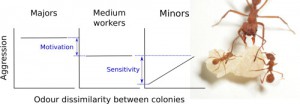 Living in a group has many advantages. One of them is that you don’t have to do everthing yourself. Often, some group members are more likely than others to carry out certain tasks. Perhaps they do it because they are better at the specific task, but maybe only because they are quicker in grasping what needs to be done. Copenhagen Master student Janni Larsen looked at behavioural variation in leaf-cutting ant nest defence behaviour and found that large workers are more likely than small workers to attack intruders. In further experiments we found that the variation was caused by different steps within the ant recognition system: while while large and medium workers were equally good in detecting intruders, but varied in their aggressiveness, smaller workers seemed to be less likely to identify intruders in the first place. Thus, behavioural variation can arise due to different mechanisms.
Living in a group has many advantages. One of them is that you don’t have to do everthing yourself. Often, some group members are more likely than others to carry out certain tasks. Perhaps they do it because they are better at the specific task, but maybe only because they are quicker in grasping what needs to be done. Copenhagen Master student Janni Larsen looked at behavioural variation in leaf-cutting ant nest defence behaviour and found that large workers are more likely than small workers to attack intruders. In further experiments we found that the variation was caused by different steps within the ant recognition system: while while large and medium workers were equally good in detecting intruders, but varied in their aggressiveness, smaller workers seemed to be less likely to identify intruders in the first place. Thus, behavioural variation can arise due to different mechanisms.
For a nice intro into the complexity of recognition systems I can recommend the Sherman/Reeve/Pfennig chapter in the 1997 edition of Behavioural Ecology. If you are specifically interested in how Acromyrmex nest defence behaviour varies, please also have a look at a recent article by Bill Hughes’ group.
Larsen, J., Fouks, B., Bos, N., d’Ettorre, P. & Nehring, V. 2014. Variation in nestmate recognition ability among polymorphic leaf-cutting ant workers. Journal of Insect Physiology, 70, 59–66.